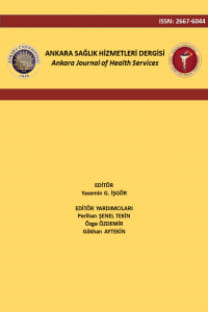Türk Adolesanlarda Menarş ve İlk Duygusal Tepkiler
Menarş, Adolesan, Duygusal Tepkiler
Menarche and First Emotional Reactions of Turkish Adolescent
Menearche, Adolescent, Emotional Reactions,
___
- Boynton, R. J., Wright R. J., Putnam F. W., Hibert, E. L., Michels K. B., Forman M. R., Edwards J.R. 2013. Childhood Abuse and Age at Menarche. Journal of Adolescent Health 52, 241–247.
- Chang, Y. T., Hayter, M., Wu, S. C. 2010. A sistematic review and meta-ethnograpy of qualitative literatüre, experiences of menarche. Journal of Clinical Nursing, 19, 447-460.
- Chrisler, J. C., Zittel, C. B. 1998. Menarche stories:reminscences of college students from Lithuania, Malaysia, Sudan and United States. Health care for Women International, 19(4), 303-312.
- Demirel, S., Terzioğlu, F. 2003. Assesment of level of knowledge on menstruation physiology
- of 5th and 6th grade girls enrolled at primary school in Sahinbey Distric Gaziantep Province. Journal of Research and Development in Nursing, 5(2), 47-60.
- Deng, F., Tao, F.B., Wan, Y., Hao, J., Su, P., Cao Y. 2011. Early Menarche and Psychopathological Symptoms in Young Chinese Women. Journal Of Women’s Health, 20, 207-214.
- Deo, D. S., Ghattargi, C. H. 2005. Perception and practice regarding menstruation. A
- compherensive study in urban and rural adolescent girls. Indian Jornal of Community Medicine, 30, 1.
- Deurgate, C. M., Buyalos, R. P., Laufer, L. R. 2004. Adolescents and developmental disorders of adolescent. In: Hacker, N. F., Moore, J. G., Gambone, J. G., eds. Essentials of Obstetrics and Gynecology: Elsevier Saunders, 387-397.
- Ince, N. 2001. Premenstrüel syndrome in adolescence. T. Clin J. Med. Sci, 21, 369-373.
- Jorm, A. F., Christensen, H., Rodger, B., Jacomb, P. A., Easteal, S. 2004. Association of adverse childhood experiences, age of menarche and adult reproductive behavior;does the androgen reseptör gene play a role?. American Journal of Medical Part B, 125B, 105-111.
- Lee, J. 2008. A kotex and simile, mothers and daughters at menarche. Journal of Family Issues, 29(10), 1325- 1347.
- Liu, H. L., Chen K. H., Peng N. H. 2012. Cultural Practices Relating to Menarche and Menstruation among Adolescent Girls in Taiwand Qualitative Investigation. Pediatr Adolesc Gynecol, 25, 43-47.
- Marvan, M. L., Abolnik M. M. 2012. Mexican Adolescents’ Experience of Menarche and Attitudes Toward Menstruation: Role of Communication Between Mothers and Daughters. J Pediatr Adolesc Gynecol, 25, 358-363.
- Mcmahan, S. A. Et. Al. 2011. The girl with her period is the one to hang her head’ Reflectations on menstural menagement among schoolgirls in rural Kenya. BMC International Health & Human Rights, 11, 7.
- Natsuaki M. N., Leve, L. D., Mendle, J. 2011. Going Through the Rites of Passage: Timing and Transition of Menarche, Childhood Sexual Abuse, and Anxiety Symptoms in Girls. Journal of Youth Adolescence, 40, 1357–1370.
- Ozdemir, F., Nazik, E., Pasinlioğlu, T. 2011. Determination of the motherly reaction to
- adolescent’s experiences of menarche. II. North American Society and Adolescent Gynecology, 24, 21-24.
- Saka, H. N., Neyzi, O. 2005. Onset of puberty is it shifting to youngers ages?. Turkish Archives of
- Pediatrics, 40, 7-14.
- Tang, C. S., Yeung, D. Y., Lee, A.M. 2003. Psyhosocial corralates of emotional responses to
- menarche among Chinese adolescent girls. Journal of Adolescent Health, 33(3),193-201.
- Tasci, K. D. 2006. Evaluation of nursing students’ premenstuel symtoms. TAF Preventetive Medicine Bulletin, 5(6), 434-443.
- Tekgul, N., Saltik, D., Sen, Y., Kurt S. 2005.The menearche age in women of 15-49 ages. STED, 14(4), 76-79.
- Tortumluoglu, G., Özyazicioğlu, N., Tüfekçi, F., Sezgin, S. 2004.The description of
- emational reaction anda ge at menarche in a rural areas. Ataturk University Journal of Nursing School, 7(2), 76- 88.
- Turan, T., Ceylan, S. S. 2007. Determination of 11-14 year old primary student’s practices and
- knowledge about menstruation. FSHD-Journal of Fırat Health Services, 2(6), 41-54.
- Uskul, A. K. 2004. Women’s menarche stories from a multicultural sample. Social Science&Medicine, 59, 667- 679.
- Yeung, D. Y. L., Tang, C. S., Lee, A. 2005. Psychosocial and culturel faktors influencing expectation of menarche. A study on Chinese premenarcheal teeneage girls. Journal of Adolescent Research, 20(1), 118- 135.
- Yayın Aralığı: Yılda 2 Sayı
- Başlangıç: 2000
- Yayıncı: Ankara Üniversitesi
Sağlık çalışanlarına uygulanan şiddet: özel bir tıp merkezi örneği
Nesrin AKCA, Ali YILMAZ, Oğuz IŞIK
Vaka Sunumu: Spondilolistezis Lumbal Spinal Kompresyon Kırığı Modifiye Chairback Ortezi
Serap ALSANCAK, Senem GÜNER, Haydar ALTINKAYNAK
Nazan TORUN, Perihan ŞENEL TEKİN
Öğrenci hemşirelerin öğrenme stratejileri ve stillerinin belirlenmesi
Sevim ÇELİK, Dilek YILDIRIM, Özdem BATUR, Elif ÇİME, Fatma ÇAPRAZ, Nagihan KUBAT
Yoksulluğun çocuk sağlığı üzerine çok boyutlu etkileri
Dilek KONUK ŞENER, Ayşe Ferda OCAKÇI
Türk Adolesanlarda Menarş ve İlk Duygusal Tepkiler
Ayşe KARAKOÇ, Fadime BINGÖL, Ayşe Ferda OCAKÇI
Vaka Sunumu: Spondilolistezis Lumbal Spinal Kompresyon Kırığı Modifiye Chairback Ortezi
